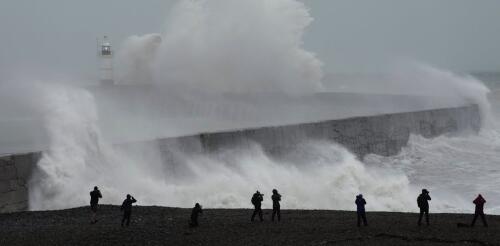Global warming
The UN weather agency is sounding a “red alert” about global warming, citing record-smashing increases last year in greenhouse gases, land and water temperatures and melting of glaciers and sea ice, and is warning that the world’s efforts to reverse the trend have been inadequate. The World Meteorological Organisation said there is a “high probability” that 2024 will be another record-hot year. The Geneva-based agency, in a “State of the Global Climate” report released Tuesday (Wednesday AEDT), ratcheted up concerns that a much-vaunted climate goal is increasingly in jeopardy: that the world can unite to limit planetary warming to no more than 1.5 degrees from pre-industrial levels. “Never have we been so close – albeit on a temporary basis at the moment – to the 1.5 degrees lower limit of the Paris agreement on climate change,” said Celeste Saulo, the agency’s secretary...
For years, climate scientists have called for a phase-out of fossil fuels to avoid catastrophic global warming. Now, according to a first-of-its-kind survey of more than 200 environmental and agricultural scientists, we must also drastically reduce meat and dairy production — and fast. Global livestock emissions should peak by 2030 or sooner to meet the Paris climate agreement target of limiting the global temperature increase to 1.5 degrees Celsius, the surveyed climate experts said. In high- and middle-income countries, which produce and consume the overwhelming majority of the global meat and dairy supply, livestock emissions should peak much earlier than in low-income countries. “We need to see major changes in livestock production and consumption — really deep and rapid changes over the next decade,” said Helen Harwatt, an environmental social scientist and lead author of the survey repo...
Global heat has seared to new extremes in recent months, and devastating climate disasters are providing powerful reminders of the costs of climate change, as governments around the world prepare for the 2023 United Nations climate summit that starts on Nov. 30. While a small window of hope remains for meeting the goals of the 2015 Paris climate agreement, the world’s greenhouse gas emissions continue to rise. This year’s climate summit, COP28, needs to be transformative. What will it take to harness a spirit of international cooperation in today’s complex, divisive and volatile world abounding in self-interest? As a former senior U.N. official, I worked for years in multilateral consensus building among often hugely divergent parties. Here are some of the challenges and negotiating techniques I expect to see as representatives from countries around the world come together in Dubai. The challenge of national self-interest To slow climate change, the world m...
Climate change is threatening the survival of plants and animals around the globe as temperatures rise and habitats change. Some species have been able to meet the challenge with rapid evolutionary adaptation and other changes in behavior or physiology. Dark-colored dragonflies are getting paler in order to reduce the amount of heat they absorb from the sun. Mustard plants are flowering earlier to take advantage of earlier snowmelt. Lizards are becoming more cold-tolerant to handle the extreme variability of our new climate. However, scientific studies show that climate change is occurring much faster than species are changing. Zebrafish have evolved to thrive in water a degree or so warmer than normal, but they struggle to survive at higher temperatures. isoft/E+ Getty Images What is evolutionary adaptation? The word “adaptation” is used in many ways by climate scientists, but it has a...
As oceans waves rise and fall, they apply forces to the sea floor below and generate seismic waves. These seismic waves are so powerful and widespread that they show up as a steady thrum on seismographs, the same instruments used to monitor and study earthquakes. That wave signal has been getting more intense in recent decades, reflecting increasingly stormy seas and higher ocean swell. In a new study in the journal Nature Communications, colleagues and I tracked that increase around the world over the past four decades. These global data, along with other ocean, satellite and regional seismic studies, show a decadeslong increase in wave energy that coincides with increasing storminess attributed to rising global temperatures. What seismology has to do with ocean waves Global seismographic networks are best known for monitoring and studying earthquakes and for allowing scientists to create images of the planet’s deep interior. These highly sensitive instruments continu...




